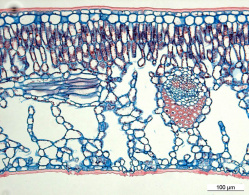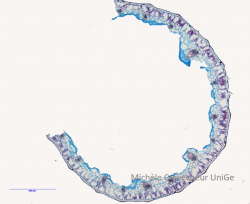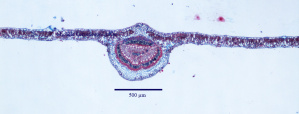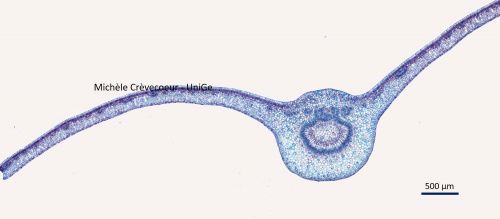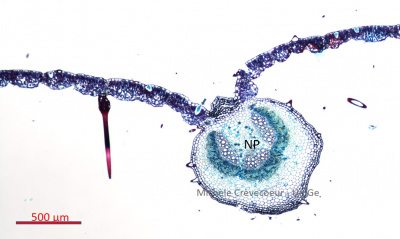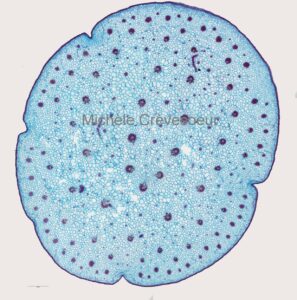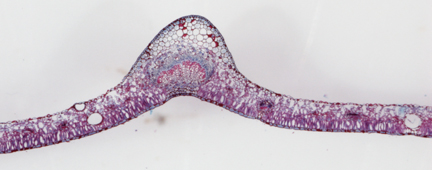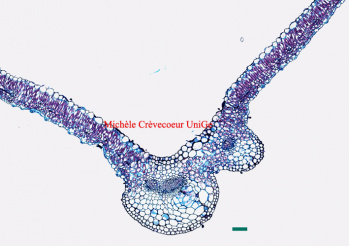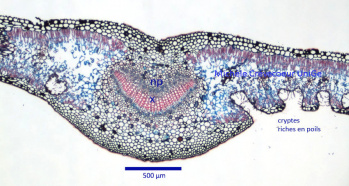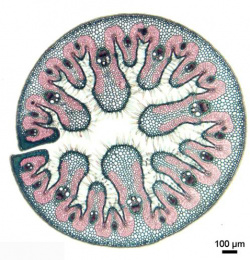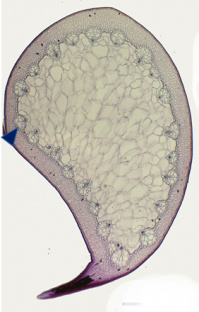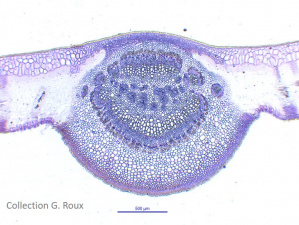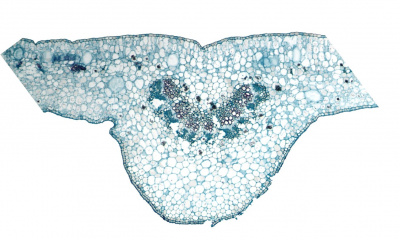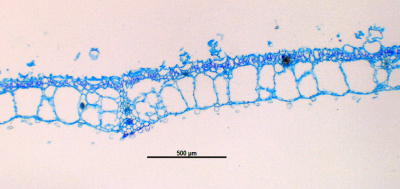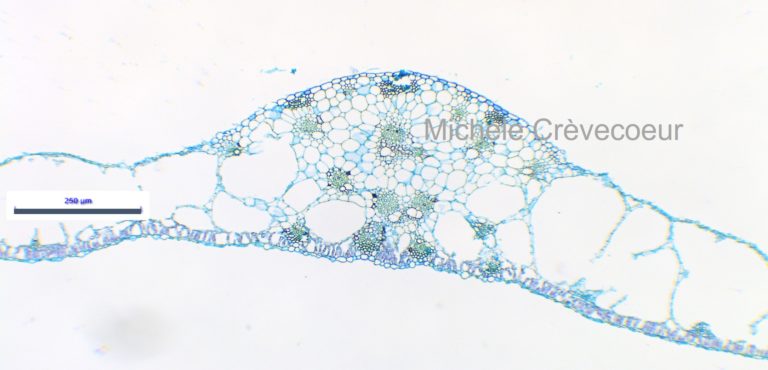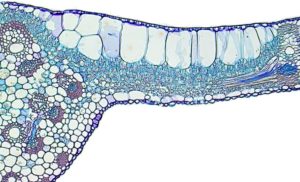Anatomy of leaf lamina
The leaf is the most polymorph vegetative plant organ and this is reflected at the anatomical level with a great variation in distribution of tissues in the lamina. The growth of the leaf is defined at the difference of roots and stems. Most generally leaves show a bifacial symmetry (also called dorsoventral) with two faces that are morphologically recognizable. In most dicots and some monocots the balde is borne on a petiole.
The leaf has most generally a flattened lamina or blade, the main structure of the leaf and most of the variation in the leaf is in the form of the lamina. The lamina is green and is the primary photosynthetic organ in plants where energy from light is converted into chemical energy. It contains veins which contains vascular tissues (xylem and phloem) in continuity with those of the stem that assure transport of water, food, and essential minerals in the lamina. Their arrangement is called the venation pattern.
Thickness, shape and size of leaves are adapted to environment. For instance, the lamina is thin in hydrophytes, thick in xerophytes.
Faces of the leaf
Leaves may be bifacial: their lamina shows a dorsoventral symmetry and is characterized by two distinct faces. For botanists the faces are designated as the adaxial face and the abaxial face. The first one is the face which appears to face the stem and the abaxial face is the side facing away from the stem. The terms of upper and lower faces are also used and are more appropriated for leaves that are horizontal.
Other leaves show two faces with the same morphology and are called iso bilateral. Still others are unifacial generally with a cylindrical form.
Lamina tissues.
Like the other plant organs, a leaf is comprised of the three basic tissue systems including dermal, vascular, and ground tissue systems.
The outermost layer of the leaf is epidermis present on both faces of the lamina. The epidermis is usually a monolayer of cells without intercellular spaces.
Some cells of the epidermis are specialized (stomata, trichomes) and the cell wall in contact with the environment is characterized by a cuticle whose thickness varies according to the environment in which the plant lives.
Between the two epidermis there is the mesophyll term used to designate the anatomical region filled with parenchyma of variable organization (homogeneous or heterogeneous). It contains vascular bundles with superposition of xylem (towards abaxial face) and phloem (towards adaxial face) as in the stem. Some leaves contain secretory tissues and supporting tissues (collenchyma, sclerenchyma) are frequently observed.
In a bifacial leaf the mesophyll is heterogeneous with two different parenchyma: on the adaxial face there is palisade parenchyma that is close to the upper epidermis of the leaves, and consists of a few rows of narrow cells, perpendicular to the leaf surface exposed to light. They are tightly packaged without intercellular spaces and contain many chloroplasts arranged around the central vacuole. In case of intensive light, chloroplasts move on the side of the cell opposite to the light exposition.
The spongy parenchyma is located on the abaxial face less exposed to light. It also contains chloroplasts but less numerous and is characterized by either small or large intercellular spaces, assuring communication with outside (O2, CO2, …).
Examples: leaves of Ilex aquifolium Nerium oleander. Differences are observed between the two leaves in thickness of their cuticle and density of stomata and trichomes.
In a leaf with two similar morphological faces mesophyll is homogeneous and consists of one type of cells without palisade – spongy parenchyma. Example: mays; sugar cane.
Light micrographs of sections in leaves from different plants are shown below.
Mays, Holly, Chive, Oak, Mistletoe, Fig tree rubber, Coffee tree, Nettle,
Aromatic plants: Officinal sage, St. John’s wort, Tarragon, pepper mint.
Plants from dry environments: Olea, Marram grass, Oleander, Australian banian fig, Aloe, Pereskia
Plants from wet environments: Water hyacinth, aquatic banana, water lettuce, cachibou.
By clicking on the pictures below you will find information on tissues and their organization in the different leaves.
Sections in leaves from aromatic plants.
officinal sage, St. John’s wort, tarragon; pepper mint
Sections in leaves from plants living in dry environments : xerophytes
Olea; marram grass, oleander, Australian banian fig; Aloe, Perskia
Sections in leaves from plants living in wet environments: hydrophytes
Water hyacinth, Aquatic banana, Water lettuce, Cachibou.
Sections in leaves from other plants:
Calathea lutea, Camellia

